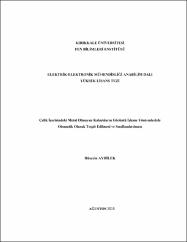Çelik içerisindeki metal olmayan kalıntıların görüntü işleme yöntemleriyle otomatik olarak tespit edilmesi ve sınıflandırılması
Abstract
Çelik üretimi esnasında kimyasal reaksiyonlar ve fiziksel etmenlerden dolayı, çelik içerisinde oluşan metal olmayan kalıntılar çelik sektörünün en önemli problemlerinden bir tanesidir. Metal olmayan kalıntılar çeliğin kalitesini doğrudan etkileyerek üretilen ürünün yorulma dayanımını düşürmektedir. Çelik içerisinde bulunan metal olmayan kalıntıların ürün üretiminden önce tespit edilerek sınıflandırılması oluşabilecek maddi ve manevi zararların önlenmesi için önemlidir. Metal olmayan kalıntıların klasik yöntemler ile manuel olarak tespit edilmesi oldukça zahmetli ve zaman gerektiren bir işlemdir. Bu işlemler esnasında sonuçlar basit bir şekilde insan hatasından etkilenebilmektedir. Bu tez çalışmasında, metal olmayan kalıntıların tespiti ve sınıflandırılmasını otomatik olarak görüntü işleme yöntemleriyle gerçekleştiren bir sistemin geliştirilmesi amaçlanmıştır. Ayrıca elde edilen verilerin istatistik olarak analizinin yapılarak daha geniş alanlar için uzunluğun tahmin edilmesi hedeflenmiştir. Sistem tarafından üretilen sonuçların uluslararası kurum ve kuruluşlar tarafından kabul edilebilmesi için uluslararası standart olan ASTM E45 referans alınmıştır. Analiz edilecek çelik örneklemlerinin görüntülerinin elde edilmesi için metal analizine uygun ışık mikroskobu kullanılmıştır. Işık mikroskobundan elde edilen görüntüler üzerinde oluşan aydınlanma probleminin çözümü için literatürde kullanılan Top-Hat dönüşümleri kullanılmıştır. Metal olmayan kalıntılarda ayırt edici özelliklerden birinin gri eşik seviyesi olmasından dolayı bölütleme işleminden önce Çoklu Otsu Eşikleme algoritması uygulanarak kalıntıların eşik değerleri belirlenmiştir. Eşik değeri belirli olan kalıntılar eşik değerlerine göre bölütlere ayrılmış ve bu bölütlere BLOB analizi yapılarak BLOB özellikleri elde edilmiştir. Kalıntılardan elde edilen uzunluk verilerine boyut filtresi uygulanarak belirlenen minimum uzunluk seviyesi altında kalan kalıntılar filtrelenmiştir. Filtrelenmiş verilerin ASTM E45'te belirtilen ayırt edici özelliklerine göre ilgili hesaplar yapılmış ve kalıntılar tip, kalınlık ve şiddet sınıflarına ayrılmıştır. Ayrıca, 6 adet örneklem ve bu örneklemlerin 4 yüzeyinin kullanılması ile oluşan toplam 24 adet yüzey üzerinde bu analizler yapılarak ilgili yüzeylerdeki en uzun kalıntı değerleri elde edilmiş ve standartta belirtilen ölçüm yüzeylerine uygun belirli bir kontrol alanı için karşılaşılabilecek maksimum kalıntı uzunluğu istatistiksel analiz yardımıyla hesaplanmıştır. Literatürde bu tez çalışması kapsamındaki çalışmalar farklı şekillerde araştırılmış ancak uluslararası kabul gören standartlar ile uyumu sağlanamamıştır. Bu nedenle bu çalışmanın metalografi alanında yapılacak diğer çalışmalar için kaynak niteliğinde olup farklı metal numuneleri için de uygulanabileceği düşünülmektedir. Ayrıca tez çalışması kapsamında kullanılan görüntü işleme yöntemlerinin diğer metalografik analiz ve ölçümlerine temel oluşturacağı düşünülmektedir. During steel production, by virtue of chemical reactions and physical factors, non metallic inclusions in steel are one of the most significant problems of steel industry. Non metallic inclusion have reduced fatigue strength of the yielded product by directly influencing the quality of steel. Recognition of non metallic inclusions in steel before yielding the product, and classification of non metallic inclusions in steel are important for preventing the probable physical and moral damage. Recognition of non metallic inclusions manually via classical methods is a fairly arduous and time consuming process. In the course of the process, results could be affected by human based mistakes. In this thesis study, it is aimed that a system is developed for non metallic inclusions in steel to recognize and classify automatically via image processing algorithm system. Furthermore, by performing an analysis statistically of data obtained, estimating the length has been targeted for more extensive areas. ASTM 45, which is internationally standard, has been taken as a reference in order to be approved of the results produced by system by the international foundations and institutions. Light microscope, appropriate for metal analysis, has been used in order to obtain images of steel samples for analysis. Since the denouement of the enlightenment problem occurring on the images obtained from light microscope, Top-Hat transformations, applied in literature, have been used. Threshold value of the inclusions has been specified by applying Multi Level Otsu Thresholding before the segmentation process on account of that gray level threshold is one of the distinguishing features in non metallic inclusions. Inclusions that have certain threshold values have been allocated in segments according to their threshold values and BLOB features have been obtained via making a BLOB analysis to these segments. Inclusions that are under the minimum extent level specified by utilizing dimension filter for length data of inclusions have been filtered. According to distinctive features, defined in ASTM E45, of filtered data, relevant computation has been done and inclusions have been classified as type, thickness and severity. Moreover, by making the analyses on 6 samples and total 24 surfaces with using 4 faces of these samples, the longest inclusion values on relevant surfaces have been obtained and maximum inclusion length to be probably encountered for a certain control area, appropriate for the measurement surfaces, defined in standarts have been calculated by means of statistical analysis. Studies in the scope of the thesis study in literature have been investigated in many ways, nevertheless, consistency of them with the internationally accepted standarts has not been realized. Thus, It is supposed that this study serves as a resource for further studies on metallography and It could be also applied for different metal samples. Additionally, It is conceived that image processing techniques used in the scope of the thesis study will form a basis for further metallographic analysis and measurements.
















